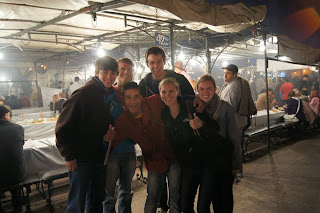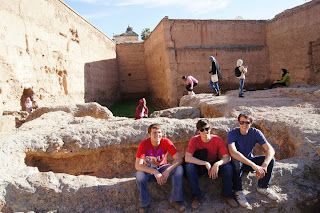No, no, no, I didn't go bungee jumping in Morocco (I wasn't presented with the opportunity). What I'm referring to is the way I felt visiting Marrakesh this weekend for 3 days. Morocco - although it's only a 2 hour flight from Barcelona and separated by 15 kilometers of water from Spain - is a completely different world. It's a developing country but boasts the most democratic government and fastest growing economy in North Africa, but it's a spectacular clash between third world and something akin to Las Vegas. I learned this weekend that even though the minimum wage is 200 euros a month, you have to prove liquid assets of 15,000 euros to travel to Europe. It costs 50 euros a month for gas and electric. You have to pay to send your kids to any high school. Oh, and it costs 35,000 euros to buy an apartment in the city of Marrakesh. So what I mean by being on a "bungee cord in Morocco" is that I had the opportunity not just to gaze at the fishbowl but take a swim, dry off, and leave. For the 31 million inhabitants and 300,000 Marrakeshians in this oddly shaped Arabic country in North Africa, there is no chance to go back to Barcelona. Or the U.S. I guess the most interesting part of the tourist spectacle in the center of Marrakesh is that it starts over every day, and this is the way they live their lives.
We arrived in Marrakesh after an early morning flight Friday and headed straight for the Choia Choia Riad (small Moroccan hotel). Although we knew the Riad was supposed to be nice, we didn't expect to have to walk through a labyrinth of back alley streets to reach the inconspicuous front door. Almost all Riads and many houses in Morocco have a central, open air patio in the middle of the house. The top floor (usually the third) is a rooftop terrace good for hanging out during the warm nights. We had our first customary cups of tea on the terrace of Choia Choia and made plans for the day.
We spent Friday walking around the city and taking it all in. We visited a palace built in 1500 by the Sultan of Morocco and wandered through it's underground passages and the Saadian tombs that date back to 1600, but the most interesting part by far was passing through the souks (open-air markets) and the main plaza Djemaa el Fna. Djemaa el Fna is something you have to see to believe - it's a huge plaza filled with tents that sell orange juice, snake charmers playing to their cobras, dancers, and impromptu restaurants at night. Picture a State Fair, make it Arabic, add snakes and monkeys, and then remember it happens every night of the year. The thing about walking through the plaza is that you can't just look, you have to participate. Walking through means getting yelled at by orange vendors to go to theirs and not the others, being approached by snake-wielding thieves (they put a snake on you behind your back and make you pay to get it off), and dancers that confront you asking for money if you take a picture. Tourism is their main industry and they fight hard for cash.
Even though you have to pay often, it's normally in small amounts. Morocco is cheap when it comes to souvenirs and food. Our first day, we ate a feast of lamb, chicken, and cous-cous for 8 euros each, and we only paid less for the rest of the trip. The food was great and we were adventurous. Most notably, everyone at the table tried chicken liver and had a hard time getting it down. Once we trusted the restaurant, we pretty much ate everything in front of us without asking questions.
The best day by far was Saturday. We each paid 45 euros to take a full day trip into the Ourika Valley and Atlas Mountains that border the city. A group of 10 of us headed for the snow-capped peaks by way of massive van. We were accompanied by a Brazilian and a friendly EU commissioner from Holland on vacation. Our guide, Mustafa, led us into a Berber village up the road and brought us into their house. The Berbers are the mountain people of Morocco that rarely come down into the city. We were welcomed in and treated to bread, tea, and an insider's look at how they lived. They didn't seem to have electricity and had just gotten running water. They kept a cow downstairs to make milk for the day, and they ate lots of cous-cous (a cheap staple).
From there, we headed for the camels. Each of us got (pretty randomly) selected for one of the 6 camels available. It turns out that Megan got a camel that had recently given birth and we later found out had a broken leg. To say the least, her camel walked like it had a wedgie and she was bouncing around the whole time. For the rest of us, there were tall and reputable camels to take us on a 20 minute trail back into the hills. It was fun, and now I can say I've ridden a camel! Megan also had the chance to interact with a wild monkey when she went to the bathroom in a restaurant nearby. I was jealous!
We then headed to a traditional Moroccan pharmacy where they taught us about herbal remedies and various concoctions. I'll skip that part not because it was suspicious but since it wasn't that exciting.
We capped off the day by hiking back 45 minutes towards a waterfall surrounded by high cliffs. This area was beautiful, and we ended up eating close to there in the Ourika Valley. I'll never forget the view from the restaurant. Even though Morocco and Marrakesh feels like a desert, there in the valley we had a view of red rock mountains, bright green trees, blue skies and white snowcapped peaks in the background. Not to mention the food was great and included in the trip's cost. That night, we were pretty tired and headed to the market to eat then went back to swim in Megan's Riad's indoor, heated pool.
Sunday was our last day there. Like many of you parents heard, there were riots in Morocco that day, but I would call them protests instead. We didn't know these were going to take place in our city until the day before we left. All in all, they were peaceful especially towards tourists because Marrakesh is a small city and we are its GDP. It was interesting because there were plenty tourists having coffee outside on the street next to the protests and being completely ignored. The movement was about protesting the high cost of living, the overly-centralized government, and the misuse of public funds. More so, it was about imitating and harnessing the spirit of rebellion that's permeating throughout North Africa.
Although that day we walked around the city as some of the shops were still open, we didn't do too much. I bought a Moroccan belt and wooden carved box for 10 euro and we walked around a bit. At night, all of the shops closed early because there was another protest planned on the other side of town. During the night protest, a McDonalds, a bank, and a clothing store were all looted. I know it wasn't the best weekend to be in Morocco, but it's notable that all of this took place far away from the tourist section of the city. These problems are the country's own, so the two sides involved are solely the government and the people of Morocco. In the Riad that night, an older man named Rasheed working at the hotel talked to me, Megan and Dave for about an hour. He told us that even though we might not suspect it, Moroccans are looking out for us tourists. He said that they consider the safety of the tourists above their own, especially during the protesting. That night, he also made us tea and gave us bread for free since we couldn't go get food ourselves (everything was closed).
The one thing Moroccans will do, though, is haggle tourists to the bone. Dave bought traditional Moroccan slippers for 15 Euro (pretty good price) after initially being asked 35 euro. Rasheed told us that he would never be asked more than 6 euro for the same shoes. They know how to get you!
As we left early Monday morning, I was wishing for a couple days more. Marrakesh wakes you up and intrigues you. I'd recommend it to anyone, especially since it's such a different experience and it felt safer than you would expect. The mountains, the camels, the unlimited cous-couse, private Riad and hot sun - what more could you want?
Me on my small but muscular and sturdy camel.
An idea of the market during the day. After our friend Inge took this picture, she was confronted and had to pay 3 euro!
Eating at the market at night! There are 40 of those food tents set up and taken down each night.
Megan fearing for her life on a broken camel.
The view behind us at the restaurant....
The six guys in our private Riad.
Wild monkey curious of digital photography.
View from the Berber house we visited.
Treated to tea, bread, homemade honey and butter at the Berber house.
Me and Megan atop the ruins of the Sultan's palace.
Two camels for the price of one!
Megan mistaking the monkey for me.
An idea of a Souk - a hole in the wall hotbed for intense negotiating.
Me, Megan and Ben at the rooftop restaurant on the first day.
This woman made tea in front of us and performed the "tea ceremony." From what I could gather, the tea ceremony involves pouring liquid from impressive heights.
Lamps, anyone?
The huge courtyard of the 16th century Palace.
The central mosque at sunset.
A view of the mountains bordering one side of the city.
Our food the first day - lamb, chicken, and cous-cous. It tasted better than it looks.
Me, Dave and Ben at the ruins.
The woman that cooked our dinner at the outdoor market. Fortunately, she did not proceed to eat from the big sppon.
Me and Megan at the waterfall.
The Arabic Coke label. Add that one to your collection, Durwood!
Lastly, the impressive view from our restaurant.
This weekend - staying in Barcelona. It's been a while since I wrote about being here! More to come.





















































